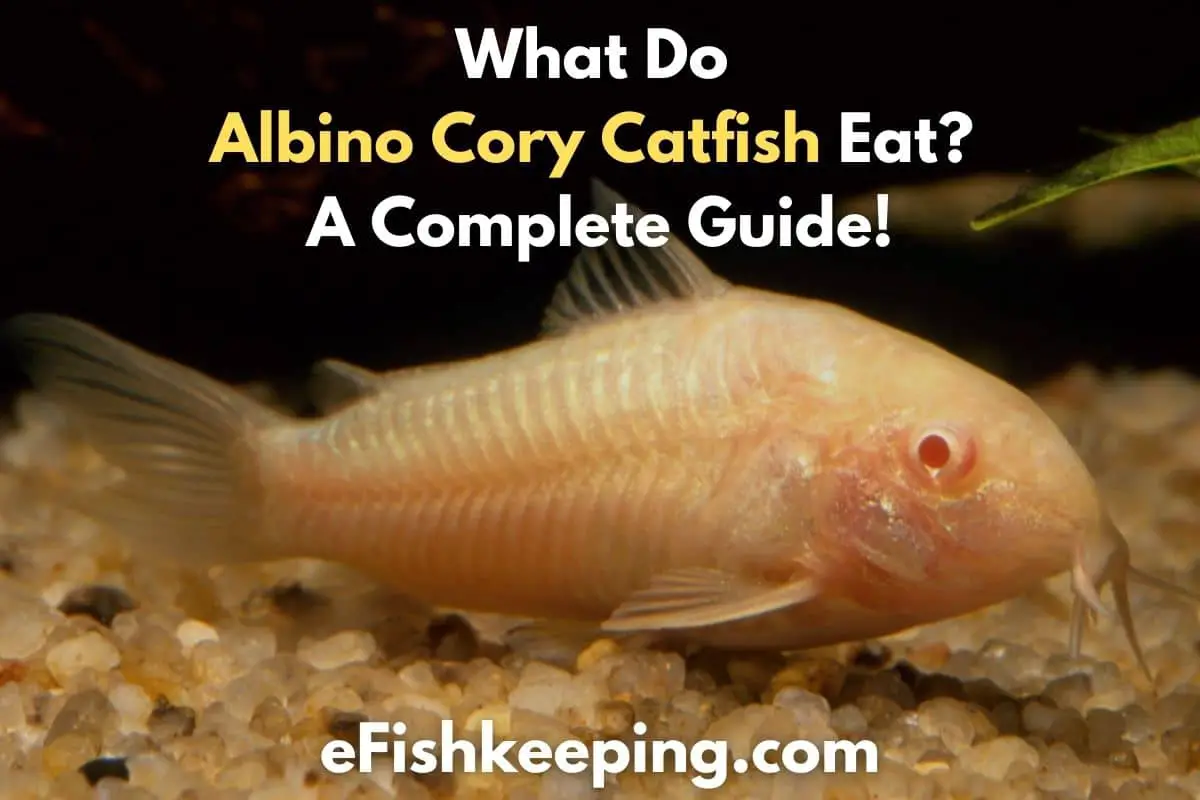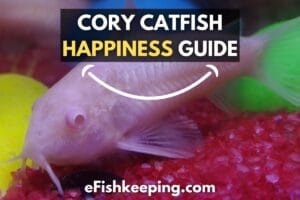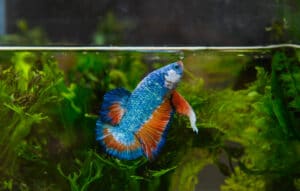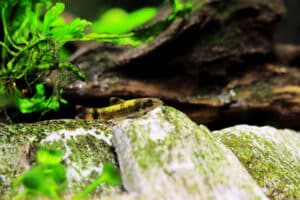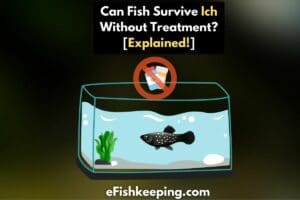Making sure your pet is well-fed is the key to keeping them healthy for a long time. If you’ve recently bought an Albino Cory catfish, you might be worried about how you should feed them. Luckily, I am about to clear up all your confusion in this complete guide on what do cory catfish eat.
In this article, I will tell you all you need to know about the dietary needs of your albino cory catfish. If you’re worried about what to feed your Albino Cory or how often you should feed it, give this article a thorough read to find out.
1. What Do Albino Cory Catfish Eat?
Albino cory catfish are omnivores. This means you can give them a plant-based or protein-based diet. Cory catfish enjoys eating different plants and vegetables.
Read: Do Cory Catfish Eat Plants?
Albino cory catfish are community-friendly bottom feeders. This means they enjoy roaming around in groups and feeding on the bottom of a tank.
Even in the wild, you will see cory catfish searching for food near the bottom of a lake or stream. Their diet is pretty versatile. Because of this, corys are also good at cleaning the tank.
As bottom feeders, albino cory tend to feed on little bits of food throughout the day. They often shovel around dirt or stones at the bottom of a tank in search of food. They feed on leftovers and whatever bits of edible debris they find near the bottom of the water.
However, because they feed themselves throughout the day, it is necessary to have extensively planned diet charts for albino corys.
Though Albino Cory catfish keep eating most of the time, remnants and leftovers are hardly enough to keep them healthy and fulfill their nutritional needs. Catfish require lots of carbohydrates, vitamins, and minerals to stay healthy.
These nutritional needs aren’t met by a catfish’s bottom-feeding tendencies. As a result, as a pet owner, you must ensure that your albino cory catfish receive additional supplements to meet their nutritional needs.
2. What Should I Feed My Albino Cory Catfish?
Albino cory catfish have very diverse palates. Thus, you can feed your catfish a range of different things, such as pellets, bottom feeder tablets, algae wafers, flakes, frozen shrimp, etc. You can also feed your catfish supplements to boost their nutritional intake and increase their metabolism.

You can’t go wrong when picking what food to give your catfish. Since Albino Corys are omnivores, they eat just about anything small enough to fit in their mouths. Try to give your catfish a variety of different foods, ranging from flakes to vegetables to shrimp and protein.
Since catfish are bottom feeders, make sure you are giving them food that will sink to the bottom of the tank. You can also feed your catfish, cooked green vegetables that sink to the bottom of the tank.

Check This Here (on Amazon)
In terms of protein, you can feed your fish frozen bloodworms or shrimp pellets. As long as the food isn’t too big to digest, your cory catfish will eat it up.

Check This Here (on Amazon)
Start with smaller foods. As your catfish grows in size, you can give them bigger chunks of food. Floating food is better for smaller catfish. Alternatively, you should get sinking food for catfish that is bigger.
For the best results when taking care of catfish, you should also consider changing the diet charts once in a while.
Since albino cory catfish eat a variety of foods, finding things for them to eat isn’t too difficult. What you need to make sure of is giving them the right amount of food and keeping track of their nutritional intake.
The biggest mistake to avoid when feeding your Albino Cory catfish is overfeeding or underfeeding. Since catfish are bottom feeders that feed throughout the day, finding the right balance to feed them can be difficult.
The ideal method is to give your catfish a portion of food that they can finish in 2-3 minutes. Giving more will make them get overweight, and giving less will compromise their nutritional wellbeing.
Catfish feed on a lot of debris and left over foods inside the tank. Though these foods fill their stomachs, they don’t help a catfish’s nutritional health. Catfish need the following nutritional profile as a rudimentary part of their diet:
| Nutrient | Percentage |
| Protein | 26-32% |
| Carbohydrate | 25-35% |
| Lipid | 4-6% |
| Digestible Energy | 8.5-9.5% |
In addition to the chart above, albino catfish also require minerals and vitamins. However, the breakdown of minerals and vitamins is more complex and cannot be generalized into percentages. If you do not want to get into the logistics of things, do not worry.
As long as you take care of your fish’s carbohydrate and protein intake, they will receive a sufficient amount of vitamins and minerals as well.
The required protein intake for catfish is still a matter of debate. A catfish’s need for amino acids and protein can vary depending on oxygen levels and the general climate that the catfish is living in.
However, to fulfill your Albino Cory Catfish’s protein profile, you can focus on mostly plant-based proteins, like soybeans, or blood worms and shrimp.
It is also necessary to note that the feeding strategies for albino cory catfish vary depending on whether you are keeping them as a pet or breeding them to sell on the market.
If you are keeping your catfish as a pet, go for the catfish food you can buy from a pet store. You can also get frozen or live worms or shrimp for your catfish to eat.
However, if you are breeding catfish, you need more complex feeding strategies.
You need to adjust your feeding strategies depending on whether you want to fatten up your fish or get them to produce eggs. Keeping track of amino acids and omega-3 fats is important when breeding catfish.
Ideally, you should adjust your catfish’s diet according to their current state. However, in general, duckweed is a very good natural feed for breeding catfish.

Check This Here (on Amazon)
Duckweed is high in amino acids like lysine and methionine. These components make duckweed the ideal source of nutrition when it comes to fish farming.
Read Also: Cory Catfish Happiness Guide Every Cory Keeper Must Read!
3. How Often Should You Feed Albino Cory Catfish?
You should feed your albino cory catfish one or two times a day. Catfish are opportunistic feeders and tend to feed throughout the day. Catfish also eat lots of debris from the tank even when you don’t feed them. Thus, feeding them more than once or twice can compromise their health.
The intervals between meals can also vary depending on the type of food you provide. For instance, if you feed your catfish something light, such as flakes or algae wafers, you can feed them twice a day.
However, if you give them heavier food, such as blood worms, you can put off feeding them again until the next day.
It is also common practice among some people to starve their fish for one day so that the fish can clear their digestive systems. You should also check the temperature of the water when you feed your catfish. Newly born fish tend to have a higher metabolism.
If you are caring for a newborn Albino Cory catfish, you can feed them more frequently than you would feed an adult fish.
For the first one or two days after a cory catfish is born, they continue to feed off of their yolk sack. After that, you can start feeding them 2-3 times a day. Make sure your cory catfish fry is growing in a separate area or compartment from the adult catfish.
Use a grow-out tank to raise the cory catfish fry. Once they are old enough to protect themselves from the older catfish, you can move them to a community tank.
Read More: How Many Cory Catfish Should Be Kept Together?
You also need to take into account the temperature of the water when you feed catfish. High water temperatures increase their metabolism. This means that during the summer, or any time the tank temperature is hotter than normal, your albino cory catfish will have to be fed more often than usual.
4. How Long Can Albino Cory Catfish Go Without Eating?
The average albino cory catfish can go from a month to several weeks without eating. It is important to note that catfish do not typically go without eating. Even when you do not feed your catfish, they will survive on other waste products in the tank.
Even though a catfish can survive a month without getting fed, you should not go more than a week without feeding your fish.
Bottom feeders, such as Albino Cory catfish, are known for being less active with limited movements. Since they don’t move much, they spend less energy and can go longer without eating.
As previously stated, even if you don’t feed your cory catfish, they will survive on other waste food debris. However, these waste products do not add any nutritional value to your catfish’s diet. So, even if your albino cory survives, it will be extremely unhealthy.
Read Also: Are Cory Catfish Hardy?
Starving your Albino Cory catfish can also cause changes in the water levels in the tank. An improper environment will lead your albino cory to catch diseases.
Albino Cory’s do not usually get sick, but high nitrate levels, improper environments, and stress can cause your fish to get sick or even die. The best way to keep your fish alive is by feeding them properly at a regularly scheduled time.
5. How To Avoid Overfeeding Your Catfish?
Overfeeding your fish can lead to the buildup of excess waste. With too much waste in the tank, your Albino Cory can fall ill or even die. To avoid it, stick to a fixed schedule and amount. Catfish feed throughout the day, so overfeeding them is a bigger issue than underfeeding them.
Albino Corys, just like all other catfish, love to eat. Thus, it can be tempting to put some more food in the tank so that they have more to eat throughout the day.
You may think of this as a harmless gesture. However, overfeeding your albino cory has severe consequences for its health. Here are a few signs that you’ve been overfeeding your fish.
Leftover Food: Normally, you want to give your catfish enough food that they can finish in a couple of minutes. If you notice leftover food at the bottom of the tank after you’ve just fed your catfish, it means you are giving them too much food.
Dirty Gravel: Excess food leads to a lot of waste production. If you overfeed your Albino Cory catfish, you will see a lot of dirt and waste in the fish tank.
Floating Pellets: Just like leftover food, you will also see floating pellets in the water if you overfeed your fish. Leftover pellets indicate that your fish is full and cannot digest any more food.
Low pH Levels: When organic waste or uneaten fish food decomposes, it leaves behind acids that dissolve into the water. These acids decrease the pH level of the water in the tank.
High Ammonia and Nitrite Levels: Low pH levels and overfeeding fish can also increase ammonia and nitrite levels in the tank. This can decrease the oxygen levels in the tank and make the fish sick.
Overweight Fish: The most obvious symptom of overfeeding is the weight of your fish. This may not be instantly noticeable. However, if your Albino Cory looks more plump than usual, you may have been overfeeding it.
Cloudy Water: With additional acids and debris in the tank, the tank water will turn cloudy. If you notice cloudy or milky water in the tank, it is a sure sign that something is wrong.
If you observe any of these signs in your fish habitat, make sure to reevaluate its feeding chart. Overfeeding is a serious issue, so try to cut down on how much food you give your fish if you are overfeeding them.
6. Do Albino Cory Catfish Eat Algae?
Algae is a common component of an Albino Cory’s diet. However, Albino Cory only eats algae wafers. They do not eat the naturally grown algae at the bottom of the tank.
Albino corys have a reputation for being tank cleaners. However, if you buy an albino cory with the expectation that it will clean the algae in your tank, you will be disappointed.
They clean the tank by moving around the substrate to look for leftover food. While they clean up leftover food and debris, they do not usually eat or clean up tank algae.
However, Cory Catfish do eat algae wafers.
Additionally, Albino Cory Catfish eats remaining food and debris from the bottom of the tank, Thus, they prevent algae blooms in your fish tank by reducing excess nutrient source for the algae.
7. Do Albino Cory Catfish Eat Snails?
Cory catfish do not eat living snails out of the shell. However, if you take a snail out of its shell and crush it into pieces, they will eat it. However, eating snails is an individual preference among Cory catfish. Though many of them do eat snails, there is no guarantee that all of them will.
Read Also:
8. Do Albino Cory Catfish Eat Shrimp?
Albino cory catfish do eat shrimp. However, they only eat certain types of shrimp. Usually, they won’t eat large or adult shrimp since those shrimp are too big for them to digest. However, albino corys do eat small baby shrimp that they can manage to fit in their tiny mouths.
Typically, unless the shrimp is extremely small, Albino Corys won’t eat live shrimp. However, they do eat shrimp-related foods such as brine shrimp or shrimp pellets. Aside from this, albino corys get most of their protein from vegetables or blood worms.
Read: Can I Feed My Fish Brine Shrimp Everyday?
9. Do Albino Cory Catfish Poop?
Like most other living creatures, albino cory catfish do produce waste. So, yes they poop. However, they can produce more or fewer waste products based on their diets.
How much a cory catfish poops depends on its size. Additionally, if you are overfeeding your catfish, it will produce a lot of waste.
Generally, catfish do not produce any more waste than any other type of fish. However, catfish do not typically eat or clean their poop. So, if your catfish’s tank is full of waste, you will have to clean it yourself.
Final Thoughts
So, to summarize, albino cory catfish are omnivores and eat a variety of different things such as algae wafers, shrimp pellets, blood worms, bottom feeder tablets, tropical granules, etc. Aside from this, albino corys also feed on leftover food and debris from the bottom of the tank.
Now that you have made it to the end of this guide, I hope it has helped you to get a clear understanding of your Albino Corys diet. If you found any value in this post, help it to reach more fishkeepers like you by sharing it. Thanks! Wish your albino cory catfish stays healthy, well-fed, and happy.
Recommended Reading:
Hi! I’m Praveen Ghoshal, the founder of eFishkeeping.com. Inspired by my Dad, I got interested in fishkeeping when I was a kid. Since then, I have been involved with this hobby. Currently, I have 3 fish tanks at our home, and I enjoy this hobby with my full family. Read more about me here.

